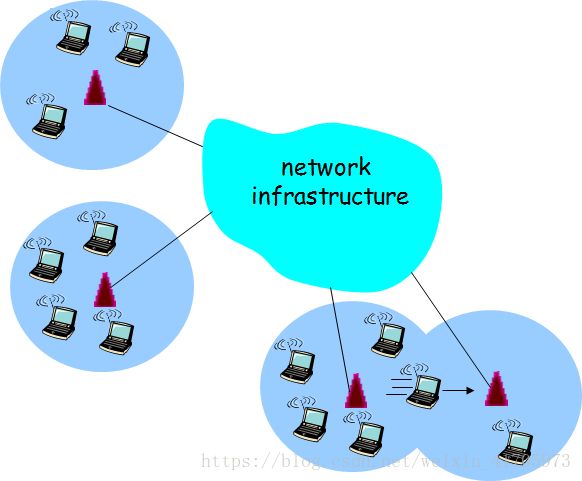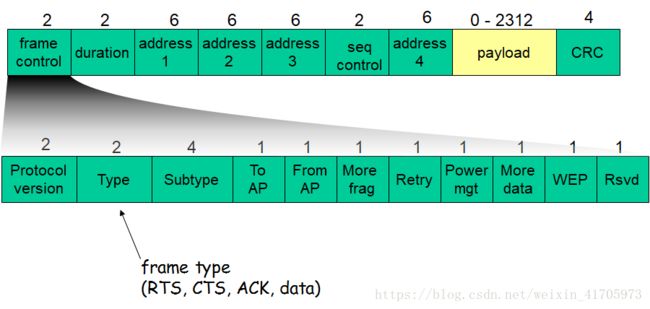802.11 Protocols in Wireless and Mobile Networks
Why Networks need to be Wireless and Mobile?
Nowadays, Network of Internet has already merged the communications networks and the computer networks, the terminal devices in subscribers are portable and mobile such as laptops, palmtops, PDAs, the number of them is keeping increasing. The challenge is how to keep wireless and mobile access Internet for so many terminal devices.
At first, we must give the detail definition of Wireless and Mobility of the Access network.
- Wireless means communication over wireless link
- Mobility means keeping ongoing communications when the user moves from one network attachment point to another.
The elements of a wireless network are sender, receiver and wireless links. In specified Wireless Access Network they are base stations, wireless hosts and wireless links, as follows.
- Wireless hosts: laptop, PDA, IP phone, run applications, etc.(wireless does not always mean mobility)
- Base stations: 1/typically connected to wired network;2/as a relay - responsible for sending packets between wired network and wireless hosts, e.g., cell towers, 802.11 access points.
- Wireless link: 1/typically used to connect mobile to base station;2/ also used as backbone link;3/ multiple access protocol coordinates link access;4/ various data rates with transmission distance.
By combining the upcoming wireless networks such as wireless mesh networks, hybrid ad hoc networks, mobile ad hoc networks, vehicular ad hoc networks, sensor networks and REID, the wireless networks have the following taxonomy:
But compared with the wired networks, there are lots of technique issues in wireless networks, i.e.,
- Decreased signal strength
- Interference from other sources
- Multi-path propagation problems
- SNR versus BER tradeoffs
- Hidden terminal and Exposed terminal in scenario of multiple wireless senders and receivers
The first 4 issues can be solved by some techniques, but last one issues need to be considered by 802.11 protocols because them will lead to more collisions.
IEEE 802.11 Wireless LAN
Taxonomy
Architecture
The base station in 802.11 architecture is called access point, obviously the infrastructure mode is used. 802.11 defined the Basic Service Set(BSS) that contains an access point and its wireless hosts. Note that ad hoc mode also can be used in hosts.
Channel allocation
The spectrum is limited, and the divided channels for 802.11 is effectively 22 MHz as above, we can see any two channel are non-overlapping if and only if they are separated by four or more channel.
- (In 802.11 b, 2.4 GHz-2.495 GHz spectrum divided into 14 channels at different center frequencies)AP admin chooses frequency for AP, note that the interference may occurs when same channel is chosen by neighboring AP.
- If hosts want to access to AP, it will do the following steps: 1/scans channels, listening for beacon frames containing AP's name(SSID) and MAC address; 2/ selects AP to associate with; 3/ may perform authentication; 4/ will typically run DHCP to get IP address in AP's subnet.
CSMA/CA
Carrier sense multiple access with collision avoidance(CSMA/CA) scheme is employed for multiple access of multi-user and multi-AP in 802.11. Three objects must be achieved by :
- CS: sense channel before transmitting and refrains from transmitting if channel is sensed busy;
- MA: multiple station send and receive on a broadcast channel;
- CA: avoid collision with ongoing transmitting whenever possible(collisions occurs when 2+ nodes transmitting at same time)
- If collisions are sensed, it is difficult to receive when transmitting due to weak received signals(fading)
- CSMA/CA can't sense all collisions in any case such hidden terminal, exposed terminal
In conclusion, the goal of CSMA/CA is avoiding collisions, so it can't eliminate the collisions.
2 work mode in 802.11 MAC protocol
Basic mode
RTS/CTS mode
802.11 frame
802.11 mobility
802.11 rate adaption
802.11 power management
- node-to- AP: "I am going to sleep until next beacon frame": 1/AP knows not to transmit frames to this node. 2/node wakes up before next beacon frame
- beacon frame: contains list of mobiles with AP-to-mobile frames waiting to be sent: 1/node will stay awake if AP-to-mobile frames will be sent; 2/ otherwise sleep again until next beacon frame
Summary of related protocols















